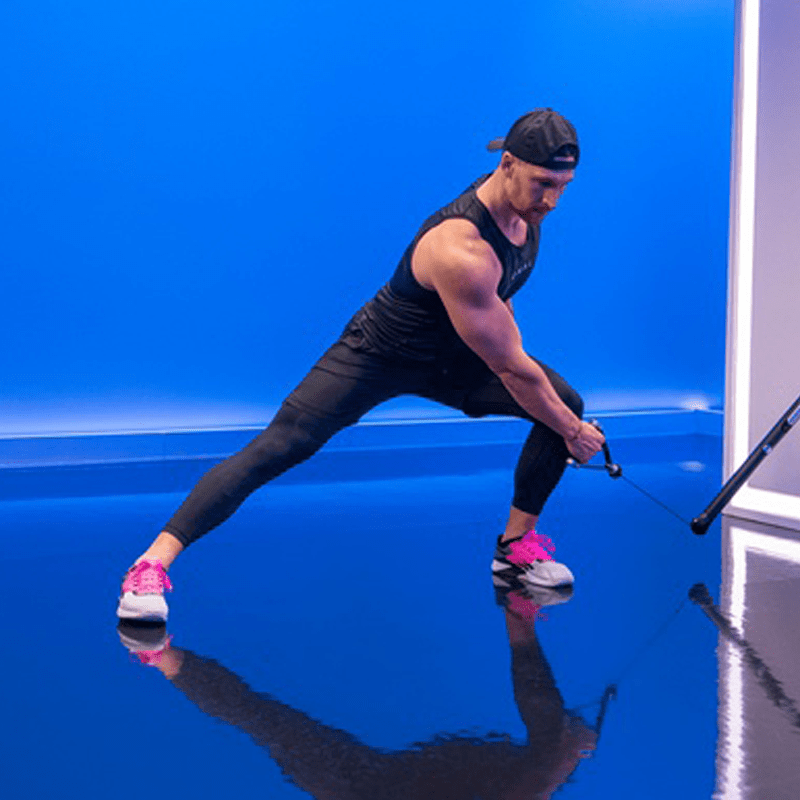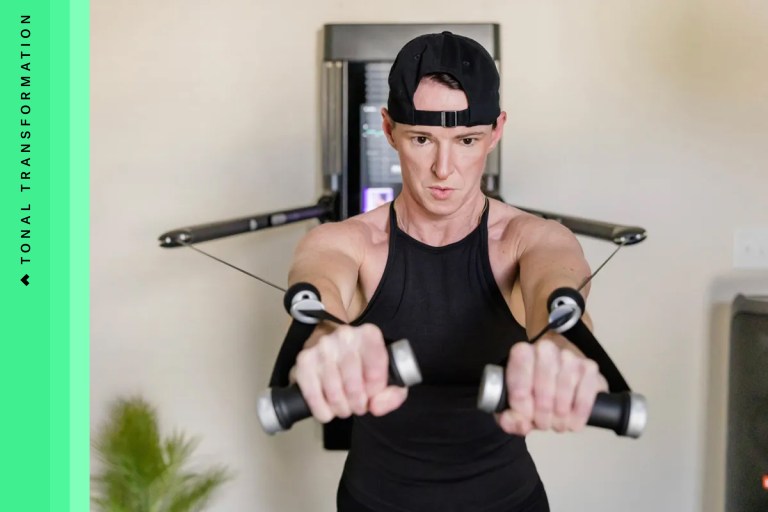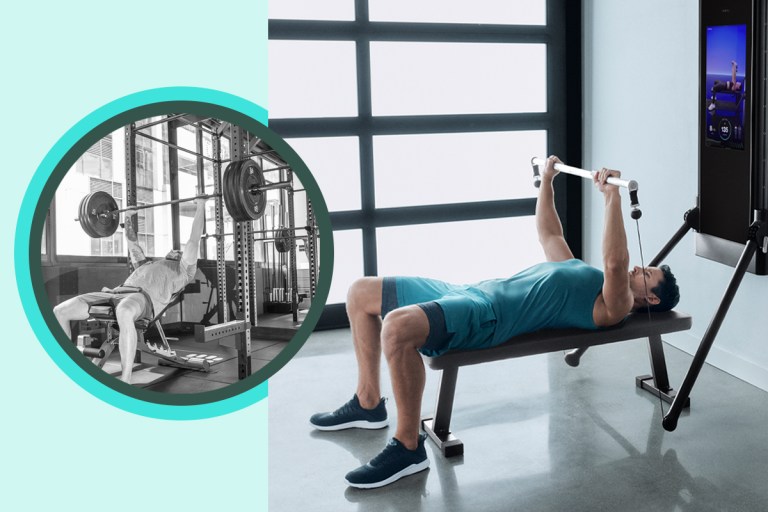Should You Train to Failure? What You Need to Know About This Technique
Here’s why training to failure can—sometimes—be the key to success.

There aren’t many situations in which failure is the goal, except for when it comes to strength training. Then, there are some benefits to training to failure—or reaching the point when you just can’t eke out one more rep.
It’s a feeling you probably know if you’ve ever failed a lift: your muscles start shaking and you feel increased tension throughout the body. “When you’re doing a pushup, [for example], you usually feel it in the triceps and the chest,” says Joe Rodonis, a certified personal trainer and Tonal coach. “But as you hit fatigue, you start to feel it more in your core, you feel the shoulders fire up, and you feel the quads getting engaged. It’s like every part of the body starts to recruit muscles to help you.”
While you can still get big gains without the discomfort that can come with failing, for advanced lifters, occasionally training to failure can help break through plateaus and lead to increased muscle growth.
What Is Training to Failure?
In the context of resistance training, training to failure most commonly refers to momentary muscular failure or the inability to complete the concentric portion of an exercise with the full range of motion and your form intact, according to Troy Taylor, Senior Director of Performance at Tonal.
The exact weight (or the percentage of your one-rep max) you’re lifting for a certain exercise isn’t as important in training to failure as it is when training for maximum strength, as you can reach failure by doing more reps of a lighter weight or fewer reps of a heavier weight.
What Are the Benefits of Training to Failure?
Whether or not you want to include the training-to-failure strategy in your lifting sessions depends on your goal and your experience level. For increasing strength and power, Taylor says reaching failure isn’t necessary and may even be detrimental to power gains. However, if you’re an advanced lifter and hypertrophy, or building muscle size is your goal, then this type of training may deserve a place in your routine—in some cases.
The idea behind lifting to failure is that you’ll activate more high-threshold motor units, thus increasing your potential to build bigger muscles. “Every time you contract a muscle, it’s going to go from [recruiting] low-threshold motor units to high-threshold motor units, and the high-threshold motor units are the ones that have the greatest hypertrophic potential,” says Jacob Rauch, CSCS, PhD candidate, and performance manager of applied training science at Tonal. “Given that high-threshold motor units are typically engaged only after the low-threshold motor units have exhausted themselves during moderate-load training, it follows that training to failure is thought to enhance the recruitment of these high-threshold fibers.”
In practice, though, results have been mixed. In reviewing data from 13 studies that included nearly 400 participants, researchers found no significant difference in hypertrophy between those who lifted to failure and those who did not, according to a 2021 systematic review of studies published in the Journal of Strength and Conditioning Research. They found that not lifting to failure actually resulted in equal or greater improvements in maximal strength and power.
However, new research suggests that training to failure may be beneficial among a specific group: experienced, trained lifters. These individuals did experience a more significant improvement in hypertrophy when training to failure, according to a 2022 systematic review and meta-analysis published in the Journal of Sport and Health Science. Additionally, a preliminary version of a study released earlier this year that looked at reps in reserve (the number of reps you feel like you could do after finishing your set), found that lifting until you had fewer reps in reserve (closer to failure) did result in increased hypertrophy gains.
This is good news for novice and intermediate lifters who won’t have to struggle with reaching failure to achieve impressive results. By simply following the principle of progressive overload (gradually increasing training stress in the form of load or volume over time), you can gain strength, power, and muscle mass without pushing yourself to failure.
How Do You Train to Failure?
Because reaching failure is mentally and physically taxing, it’s not recommended that you go to your endpoint in every set of every move. “For most of your training sessions, going close to failure, but not to failure, is probably ideal for muscle mass,” says Taylor.
In fact, lifting to failure too often could leave you so fatigued that you’re unable to accumulate the adequate volume needed to build muscle. “The total amount of work you do is the most important thing for hypertrophy,” says Rauch. “And if you’re training to failure every set, you’re going to have a lot of neuromuscular fatigue that’s going to carry over into the next set which may lower the total amount of work you can do. At the end of your workout, if you’re doing less work, then failure training isn’t going to be ideal.”
Instead, limit this intense type of training to occasional workouts. For example, Rauch suggests training to failure if you’re very strapped for time and only have a few minutes to work out. When there’s no time for a full lifting session, an advanced exerciser could simply rep out a few sets to failure for a beneficial stimulus.
Another good time to train for failure is during the last set of an exercise. “If you’re planning to do three to four sets and you go to failure in the first set, it means sets two, three, and four are going to be relatively low quality,” says Taylor. “You’re going to be fatigued, you’re not going to be able to express force, and therefore you won’t get the maximum hypertrophy benefit.” This method also guarantees you’ll get the bulk of your workout volume done before accumulating too much fatigue.
Similarly, if you’re programming a multi-week training cycle, you might want to leave some reps in reserve for the first couple of weeks and then push yourself to failure in a few exercises during the final week of performing the same program.
Also, Taylor suggests keeping your failure training to isolation exercises (such as bicep curls or tricep extensions) rather than compound moves (including bench presses and deadlifts) that could pose more of an injury risk if your form breaks down. “It’s much less physiologically and even cognitively demanding to go to failure in an isolation exercise than it is in a compound exercise,” he says.
While you can do any lift to failure, here are some training techniques that allow you to reach failure quickly and efficiently:
Supersets: Back-to-back sets of the same exercise or exercises that target the same muscle group (such as a bench press and a pushup) with minimal rest in between will get you to failure fast.
Myo-reps: First, you’ll perform a high-rep, lighter-weight set to activate your muscles, then do repeated heavier-load, lower-rep sets of the same exercise with short rest periods until you reach failure.
Drop Sets: Sets in which the reps increase and the resistance drops until you’re unable to complete another rep. On Tonal, Burnout mode automatically lowers the weight as you start to fail to simulate the drop set effect.
Pre-Exhaustion Training: In this advanced lifting technique, you’ll pair an isolation exercise with a compound move (for example, a chest fly before a bench press) to fatigue your target muscle before hitting your main set.
Training to Failure on Tonal
Give training to failure a try in one of these coach-led programs and workouts on Tonal. You’ll learn how to safely push your limits and maximize efficient muscle building.
House of Volume – Coach Joe Rodonis

In Tonal’s highest-volume program yet, you’ll use supersets of similar movement patterns to push your muscles to failure and accumulate serious volume to drive hypertrophy. Rodonis suggests including this type of training for advanced lifters no more than one or two months of the year. “It’s a high energy expenditure and it takes a lot from the body,” he says.
Power Build 2 – Coach Joe Rodonis

Most of the workouts in this program end with a long-duration, 60-second set of a single exercise. The goal is to keep repping it out to the finish line. “You know you’re going to hit failure, so you just go for as many reps as you can until you can’t do anymore,” says Rodonis.
Shock PPL – Coach Ackeem Emmons

In this three-day-a-week Custom by Tonal program, you’ll use “shock sets” of 6-12-25 reps guaranteed to take you to failure, while the push-pull-legs split allows for plenty of time to rest and recover in between workouts.
Drop Set Strength – Coach Joe Rodonis

This program takes advantage of Burnout mode for effective drop sets that’ll have you packing on the muscle in less time.
Extreme Accumulation – Coach Joe Rodonis

This advanced-level Custom by Tonal program is all about breaking through plateaus by getting in lots of reps. Taylor points out that you’ll be approaching failure in the final two weeks as the volume builds up.
Lift to Failure – Coach Kendall “Woody” Wood

In this upper-body workout, you’ll use Burnout mode in isolation exercises targeting the shoulders and triceps to fatigue these muscles.


